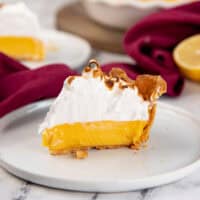Looking for the PERFECT lemon meringue pie that consistently makes a deliciously tangy, rich pie that is not too sweet, and just perfect in every way? Then this is it!
My secret? Unlike most recipes, I use a cooked filling for this lemon meringue pie which takes all the guesswork out of baking the pie! No overcooking or undercooking to worry about, the filling is never runny or watery, and the pie crust will always remain flaky and crisp without ever getting soggy!
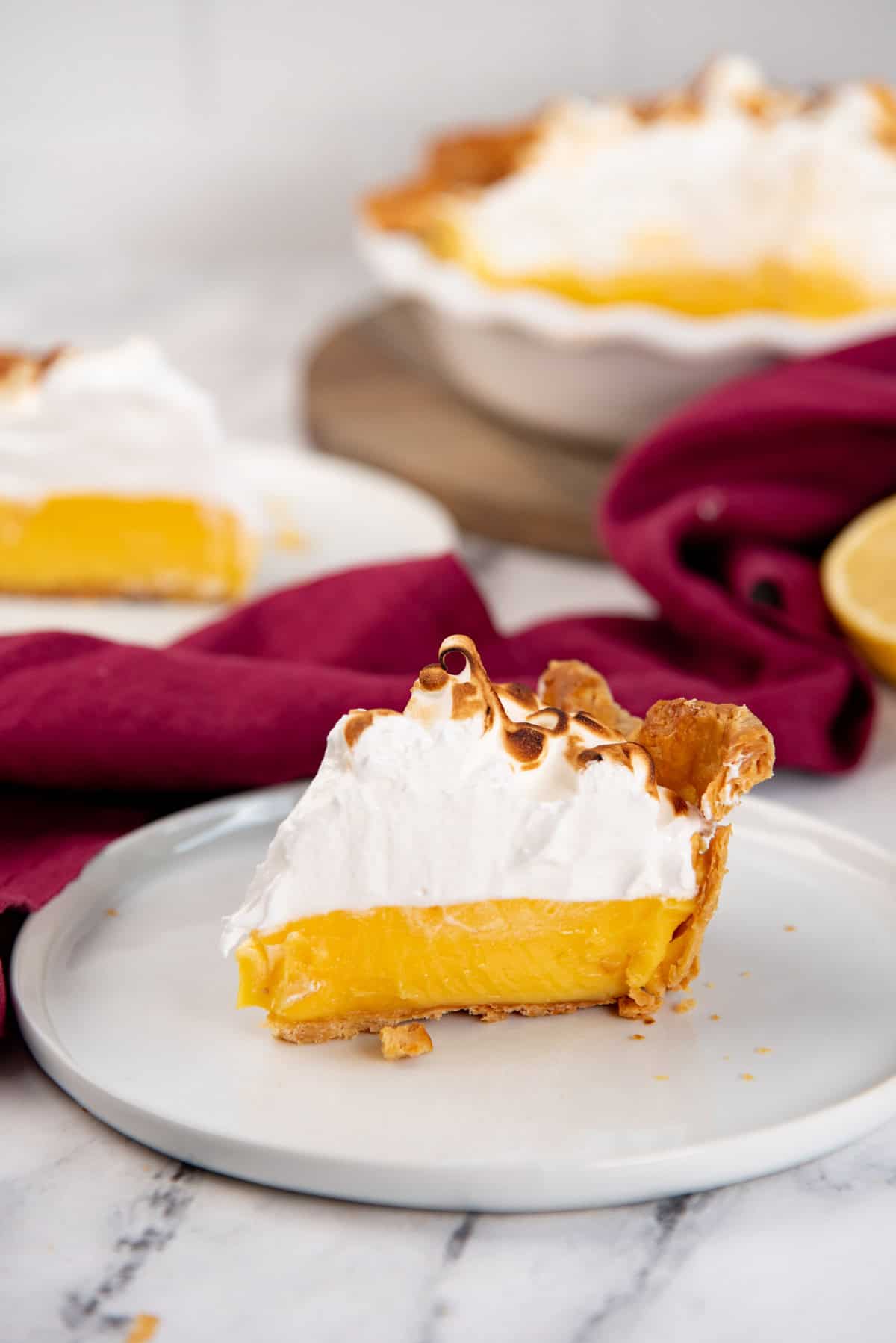

What to expect from my perfect lemon meringue pie recipe
If you’re like me, then you don’t want a lemon meringue pie that is super sweet. You’re looking for a lemon meringue pie that is really tangy, with a big punch of lemon flavor, with just enough sweetness!
All lemon meringue pies that I’ve eaten in the past were just too sweet for me, and were missing that big burst of tangy, tart lemony flavor.
That tangy lemon pie filling, balanced with the pillowy, marshmallow-like meringue topping, and a buttery, flaky pie crust is what makes the best lemon meringue pie recipe. And it’s one of my favorite dessert pie recipes.
That’s why you will love this recipe! This recipe is,
- Made with lemon juice and no added water. So, the lemon flavor is BOLD!
- Just perfectly sweetened, and does not overpower the lemon flavor.
- Buttery, lemon filling that tastes rich and creamy!
- The lemon meringue pie filling is cooked on the stove top, so you don’t have to bake it again. It sets to a firm but creamy filling with a buttery, sweet, and extra lemony flavor! There’s no guesswork with baking and hoping the filling sets either.
- Perfect, flaky pie crust that complements the lemon meringue pie in every way.
- Topped with a meringue topping that is stable, with no weeping, and can be caramelized in the oven or with a kitchen torch / butane torch.


Ingredients for lemon meringue pie
Pie crust
One pie crust to line a 9 – 9.5 inch deep pie pan. I use my perfect, flaky pie crust recipe! The recipe makes 2 crusts, but you can halve it and make just one crust. The ingredients are,
- Flour
- Butter
- Salt
- Chilled water and vodka (optional)
Lemon filling
- Lemon juice
- Egg yolks
- Cornstarch
- Sugar
- Salt
- Butter
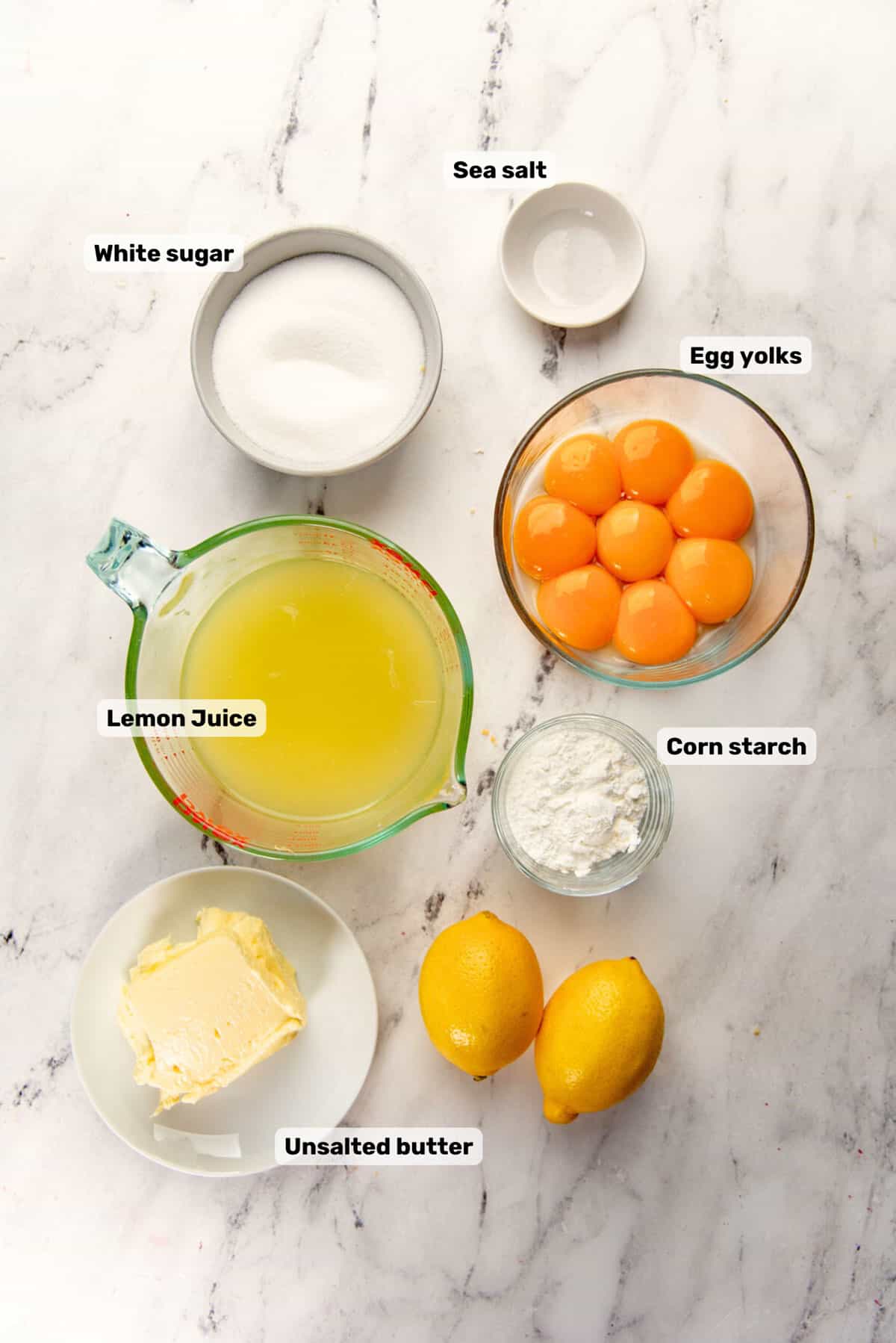

Lemon meringue pie fillings are usually made two ways.
Baked filling – Where the lemon filling ingredients are mixed (and might be cooked halfway through), poured into the crust and then baked until the filling thickens and sets. Like a baked custard.
This method is great and the filling usually looks smoother and is softer. But the pie crust must only be parbaked, and it isn’t always easy to tell exactly when the filling will be cooked. If it’s overcooked, it becomes too “scrambled”, and if it’s undercooked, then the filling is runny and doesn’t hold its shape.
Cooked filling – The lemon filling is cooked on the stove top and is like a lemon curd. This is how I make the filling for this pie. This method gives the baker more control, as you can thicken it on the stove and then pour it into the crust. Once refrigerated, the filling will be set.
Some of the cooked fillings can use gelatin as a setting agent, or use starch as a thickener. I use a combination of starch and butter to help thicken and set the filling. Because the butter not only thickens and helps set the filling, but also adds a lot more flavor to the lemon filling!
Meringue topping
- Water
- Sugar
- Egg whites
- Cream of tartar
- Lemon zest (optional)
How to make lemon meringue pie
There are 3 components to this easy recipe
- Crust
- Lemon filling
- Meringue topping
How to make the pie crust
You can totally use store-bought pie crust for convenience.
However, I absolutely love my homemade flaky butter pie crust instead. The buttery flavor is so much better in this homemade crust, and the flakiness pairs perfectly with the rich filling!
I have a very detailed pie crust recipe that will walk you through the process of making the best pie crust. So even if you’re not familiar with making pie crust, my recipe will make you feel confident!
To make this, chilled butter is cut into flour to form large flour coated butter lumps. The flour-butter mixture is mixed with just enough chilled water (and vodka) to form a dough that still has dry spots.
The dough is cut into 4 and stacked and flattened to form a dough disc. This makes the pie dough even MORE flaky (similar to how I make classic cream scones)! Then let the dough rest in the fridge.
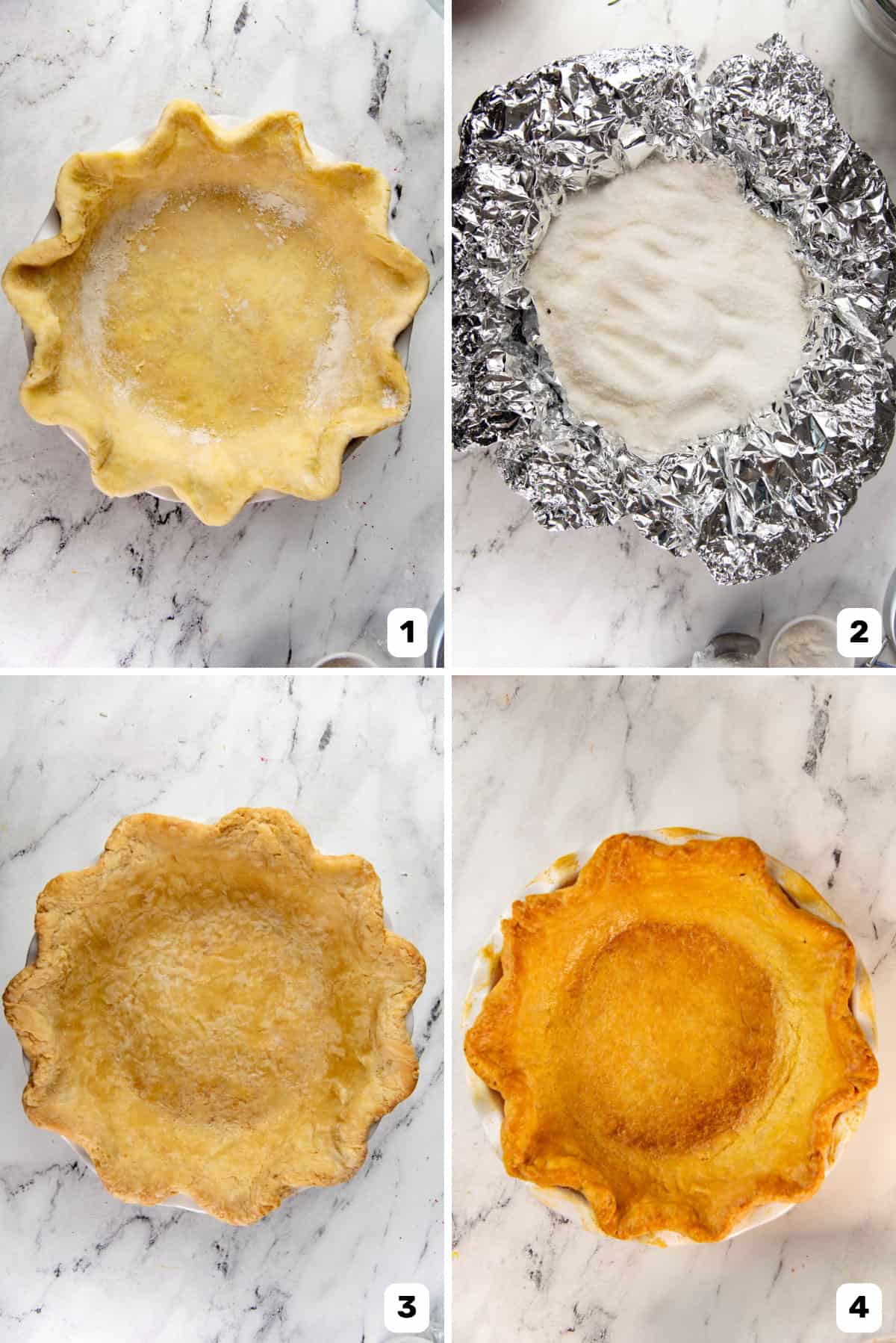

Roll out the rested dough and line your pie plate with the dough (image 1). Then blind bake the pie crust in the oven. Unlike other recipes, I like to blind bake my pie crust at a lower oven temperature of 350 F / 180 C, with rice or sugar as pie weights (image 2).
This lower but longer bake time has several advantages,
- The pie crust sides will not slip down the sides of the pie plate.
- There will be very little shrinking of the dough, as the bake time is slow and low.
- Even browning of the bottom of the crust while creating lovely flaky layers!
Once the pie crust is fully blind baked (image 3), I brush the inside of the crust with an egg wash during the last 5 minutes of baking. This will,
- Prevent the filling from making the pie crust soggy.
- Give the pie crust a beautiful golden brown sheen (image 4).
Lemon filling
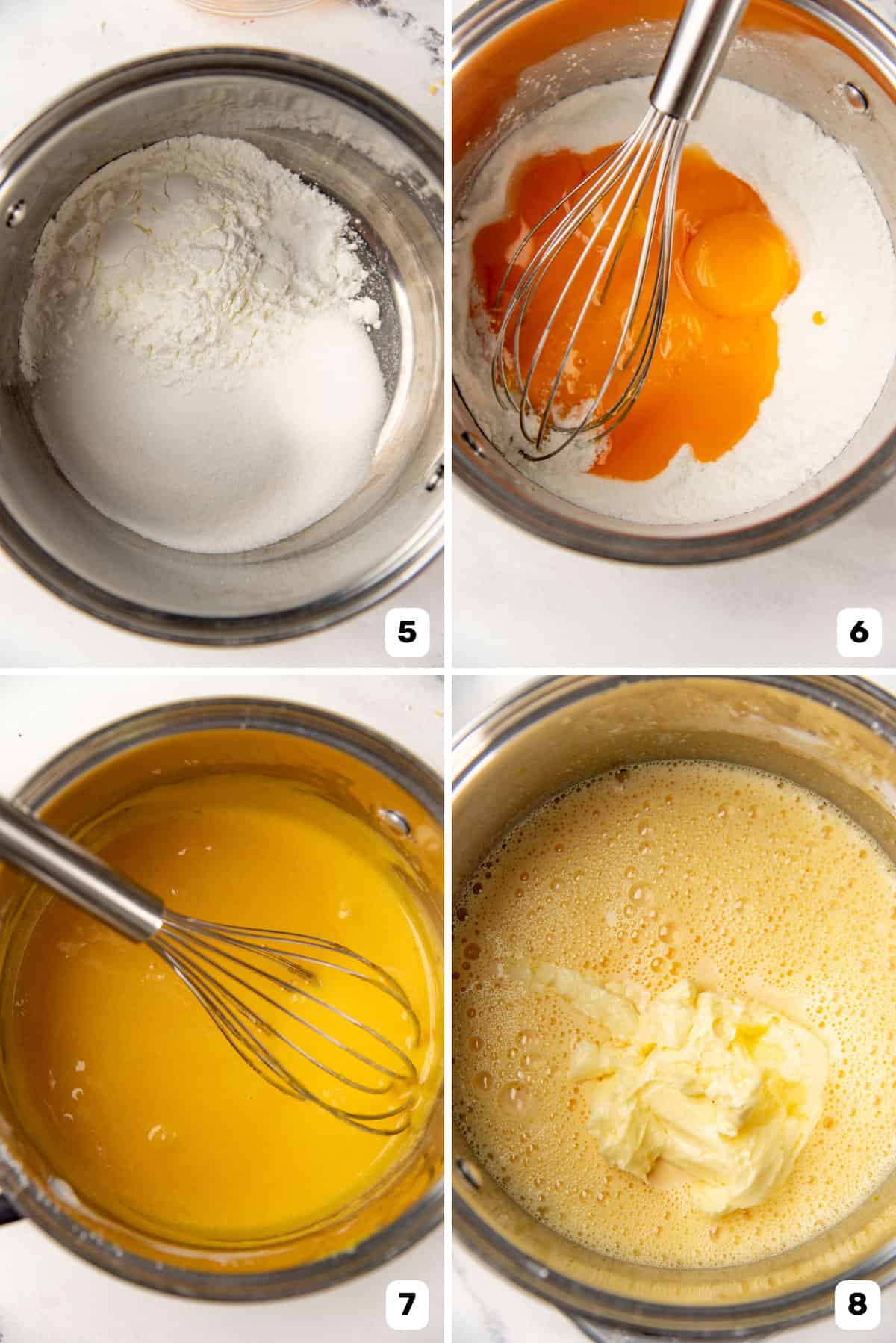

Whisk the cornstarch and sugar together in a pot (image 5). To this, the egg yolks are added and whisked in until pale in color (images 6 and 7).
Then you whisk in the lemon juice. Then the butter is placed in the saucepan (it does not need to be melted prior to adding it) (image 8).
Now, it’s time to cook the filling. Cook the filling while whisking. The whisking will keep the liquid moving, which will evenly distribute the heat in the mixture, and also help prevent the egg yolks from scrambling.
Keep cooking the mixture until the liquid starts to come to a boil. Boiling the mixture is important because the cornstarch’s ability to fully thicken the filling will only be activated when it’s heated to the boiling point.
When the mixture comes to a boil, lower the heat slightly and keep cooking the filling while whisking for a further 3 – 5 minutes. It’s absolutely crucial for the mixture to be cooked further once it comes to a boil.
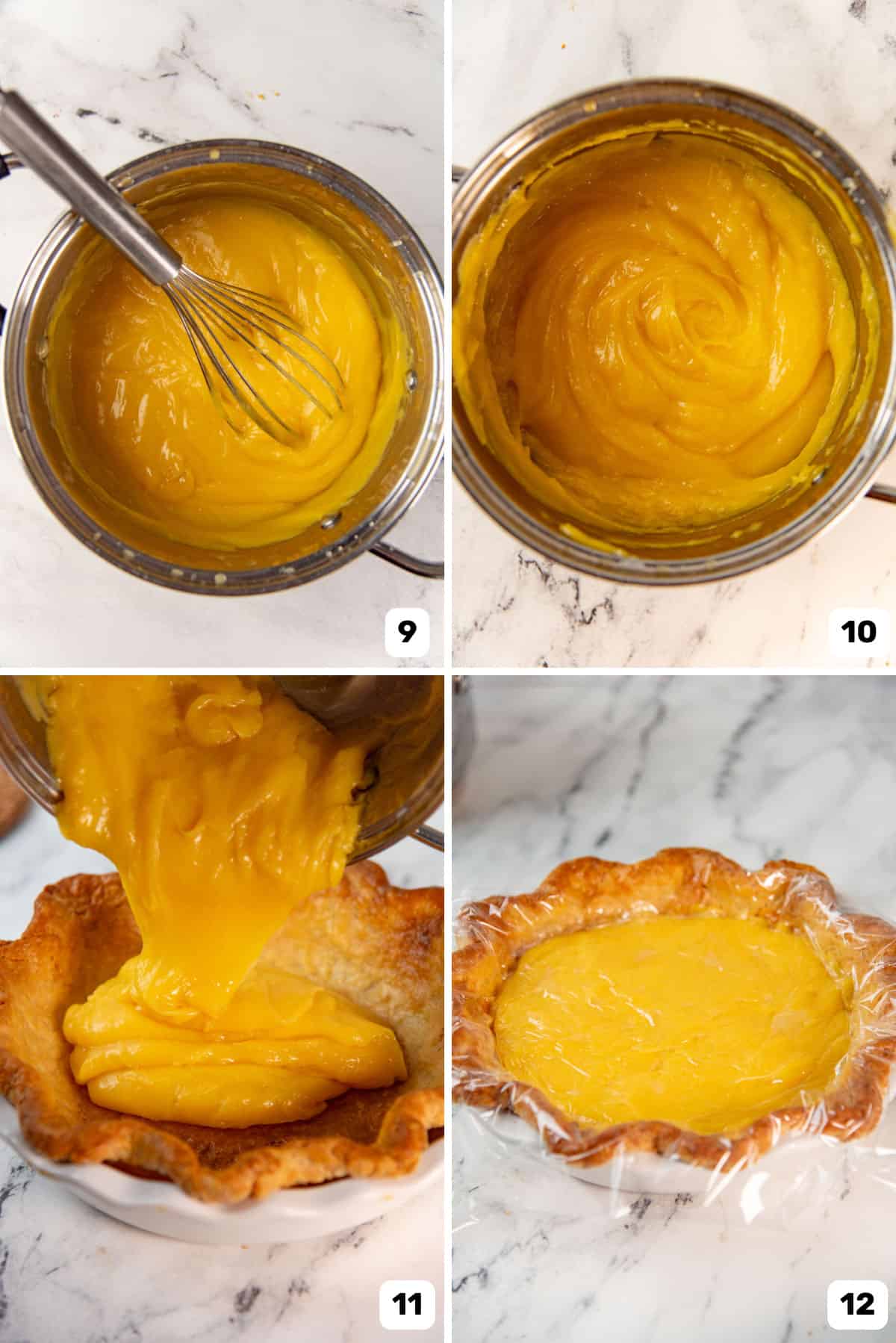

After cooking the filling, on low heat after it came to a boil, the mixture should be thick, shiny, and spreadable (image 9).
Remove from the heat and pass the mixture through a sieve. You can also use a stick blender and blend the mixture. This is an optional step.
Let the creamy lemon filling slightly cool down (image 10), and while still warm, pour it into the cooled down pie crust (image 11). Use a palette knife to spread and smoothen the surface of the tart lemon filling. Cover the entire surface with plastic wrap and refrigerate until the filling is set and cooled down (image 12).
Meringue topping
There are three ways to make the meringue topping.
- French meringue – Whisking sugar and egg whites together. This is the technique used to make pavlova for instance.
- Swiss meringue – Heating the egg white and sugar together and then whisking it.
- Italian meringue – Making a sugar syrup (high concentration) and then whisking egg whites while adding the sugar syrup.
While many recipes use Swiss meringue to make this dessert, I use Italian meringue, because it’s the most stable out of the three, and still ensures a deliciously billowy meringue.
Place water and sugar in a pot and heat to bring to a boil. Swirl the pot to help dissolve the sugar in the water. Avoid stirring it because this can recrystallize the sugar and seize the syrup.
Heat the syrup until it reaches 240 F / 116 C. This is at the starting point of the firm ball stage. You can read more about sugar syrup / candy stages in my cooked sugar stages (candy temperature chart) post. Once it reaches 240 – 242 F, it’s ready to be added to the egg whites.
If you don’t have a thermometer
Firm ball stage can be tested by dropping a few drop of the sugar syrup into a small bowl with cold water. This is the cold water test.
The sugar syrup will form a ball in the water and then if you pick it up, the ball will retain its shape mostly, but will be malleable if you press it with your fingers.
While the sugar syrup is heating, place the egg whites in a clean mixing bowl, and make sure there are no fatty residues in the bowl. Add salt and the cream of tartar into the egg whites and whisk until the mixture becomes frothy.
Add the hot sugar syrup into the egg whites while whisking on medium high speed. Once all the sugar syrup is added, whisk on high speed until the meringue forms stiff peaks and it’s only warm to the touch.
The fluffy meringue topping is now ready (image 14). You can either spread it on top, or use a piping bag to pipe a pattern over the lemon filling.
Final step


Once the lemon filling is chilled and set in the fridge, remove the plastic wrap from the surface (image 13). Make sure the surface of the filling has no moisture.
Place the meringue in a piping bag with a piping tip, IF you want to pipe the meringue in a pattern. OR, you can just spread the meringue directly on top (image 15).
Use a spatula to spread the meringue (image 16), making sure it’s spread from edge to edge while creating a nice mound of meringue, so that the center is higher than the edges.
If you have a kitchen blow torch, carefully torch the meringue to caramelize it.
However, if you don’t have a blow torch, use the broiler function in the oven to caramelize the meringue. Make sure the meringue is closer to the middle of the oven, so that it doesn’t caramelize too quickly and burn. Place the pie in the fridge to cool down the meringue before serving.
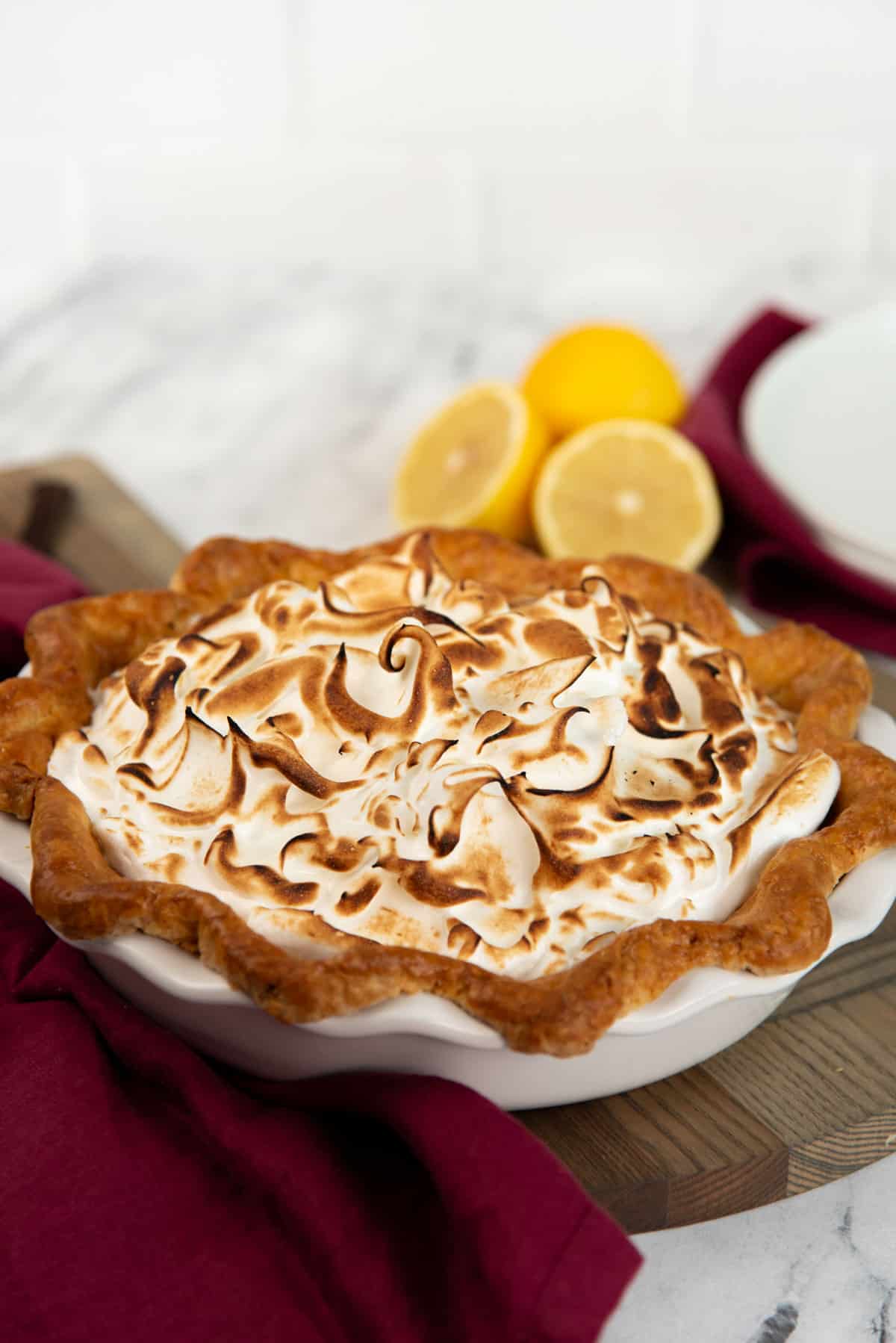

My best tips (and why this recipe works!)
- When blind baking the pie crust, bake low and slow! This will help prevent shrinking and slipping of the pie crust.
- When baking the pie crust, make sure to brush the interior of the crust with an egg wash or egg white wash during the last 5 minutes of blind baking. This will act as a barrier betwen the filling and pie crust, keeping the crust crisp and flaky.
- Use freshly squeezed lemon. The lemons should be fresh as well. Old lemons lose their flavor as they go stale.
- Whisk the filling as you’re cooking it. This will prevent the eggs from scrambling, and result in a smooth, rich lemon filling.
- Instead of cornstarch, you can also use instant clearjel or cook type clearjel. If you plan on freezing this lemon meringue pie, then use instant clearjel as this holds up to freezing and thawing the best.
- Spread the filling while it’s warm in the cooled down crust. This will make it easier to spread it smoothly.
- If you’re not sure if the mixing bowl is free from fat to make meringue, lightly soak a paper towel with white vinegar and rub this all over the inside of the bowl.
- Use a candy thermometer to get the temperature of the sugar syrup right. If you don’t have a thermometer, then use the cold water test (explained above) to check when the syrup is heated to firm ball stage.
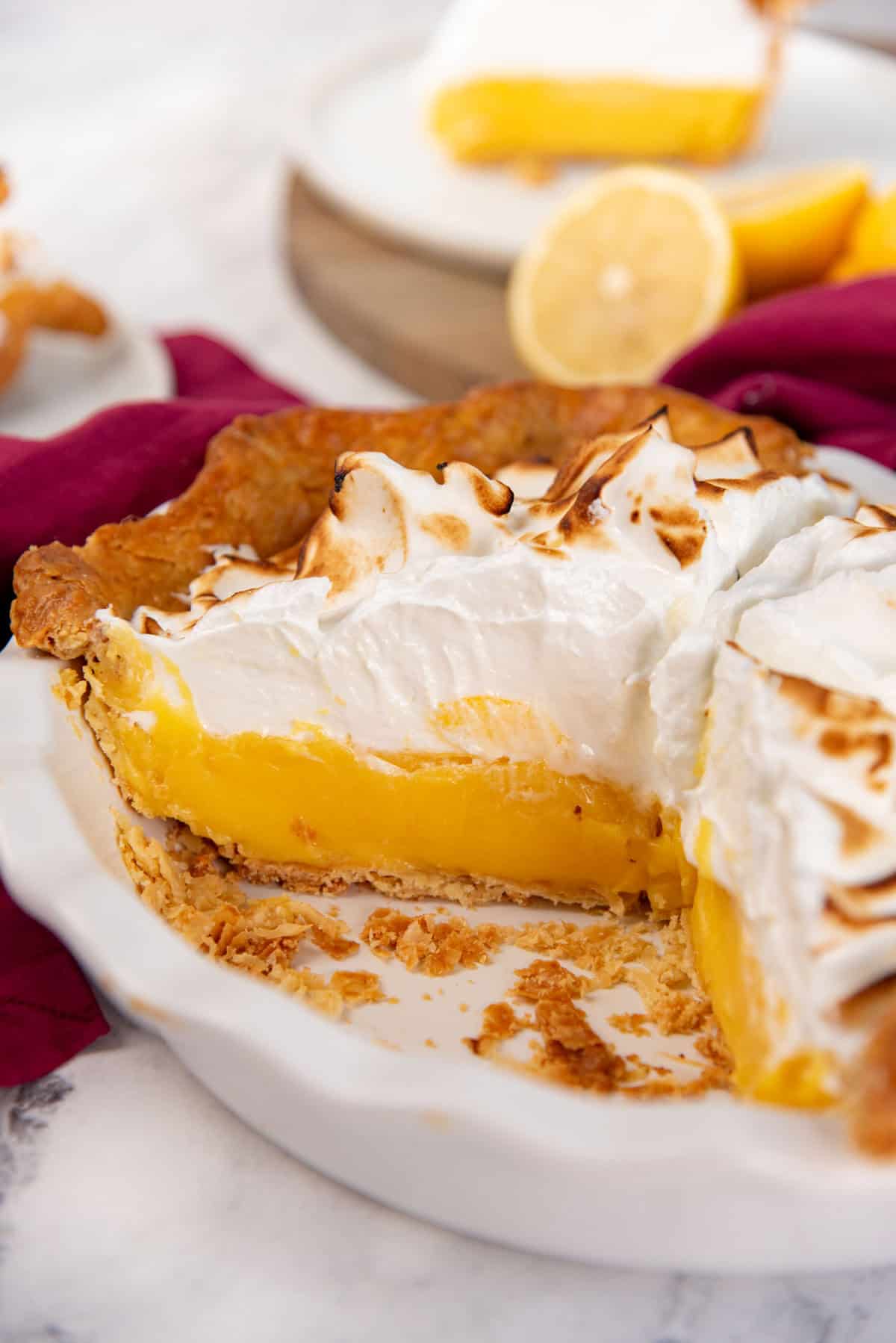

Tips on how to cut clean slices
- Use a very sharp kitchen knife or cake knife.
- Warm the blade by dipping it in hot water and then wipe it dry. The warm blade won’t stick to the filling and will slide right out.
- Guide the knife into the pie, starting from the middle, and then slowly lower it until you get to the crust. Firmly and gently cut through the crust. Once you get to the bottom of the pie, press down the knife blade firmly to cut through the crust. Remove the slice using an angled palette knife or pie server.
- It does often help to cut a very thin sliver of the pie first to create a gap in the pie dish. This first “slice” will be thin, and messy, but will allow you to cut more neatly and remove slices easily.
How to store lemon meringue pie
Make ahead tips
The lemon meringue pie without the meringue will last in the fridge for up to 5 days. But this homemade pie is best served within the first 2 days. The longer the pie is stored, the more the crust will become stale and soggy as well.
Once you cover the top of the pie with the meringue, the pie is best served the same day. But, the whole pie can be stored for up to 12 hours as well. That’s because of the Italian meringue that I use here, which is the most stable meringue.
That being said, the meringue will still start to lose volume and will interact with the filling as more time passes by. This will result in the meringue weeping and sliding off the pie.
So if you want to make this ahead of time, the lemon pie can be made up to 2 days ahead of time, but the meringue must be made on the day you plan to serve it.
You can also freeze the lemon meringue pie without the meringue, ONLY IF you use instant clearjel in the filling. Let it thaw out in the fridge overnight. The crust will lose some of its crispness though.
Storing leftovers
You can store leftovers in the fridge in an airtight container. However, we don’t keep leftovers for longer than an extra day, because of the meringue topping.
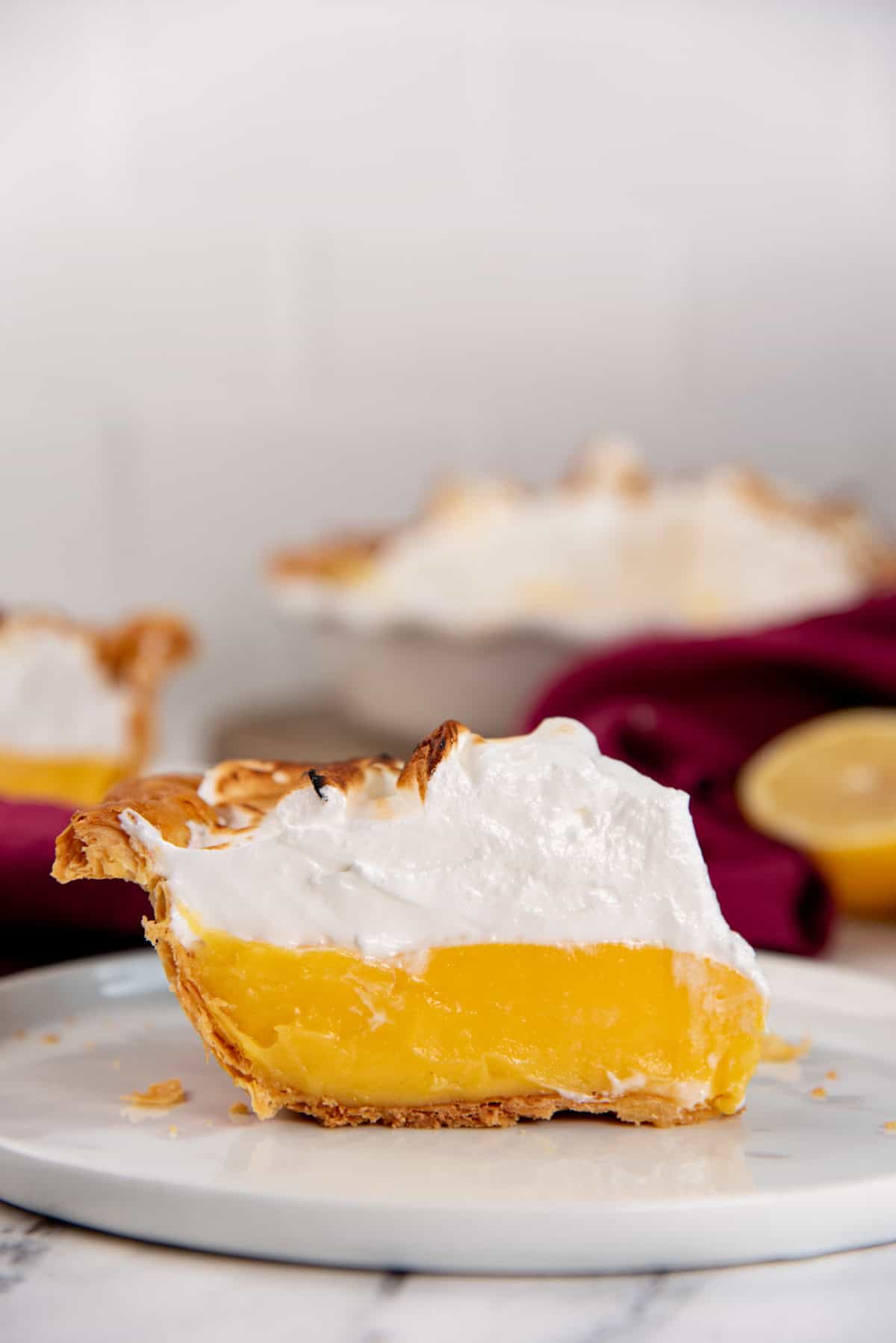

Commonly asked questions
You can freeze a lemon meringue pie with a few modifications. I would caution against freezing and thawing a lemon meringue pie that is made with cornstarch.
But if you make the lemon meringue pie with instant clearjel, then you can absolutely freeze it.
It’s also better to freeze the pie WITHOUT the meringue topping.
Let the pie thaw out in the fridge over 24 hours, and then top it with the meringue just before serving.
With the cooked filling method I use in my recipe here, it’s SO easy to keep the crust from getting soggy!
This is why I recommend brushing the inside of the pie shell with an egg wash. The egg wash bakes and creates a barrier between the crust and the filling, and prevents the crust from getting soggy too quickly.
A more permanent and better barrier would be to brush the inside of the crust with melted cocoa butter. The cocoa butter will form a thin layer of fat that will keep the filling from being absorbed by the crust.
This is NOT an issue with this cooked filling lemon meringue pie. Usually, with a baked filling, if you undercook or overcook the filling, it can cause the water from the filling to weep out. This causes water to pool on the surface of the filling.
With the cooked filling that we use here, IF there is any water on the surface while the pie chills, it’s only caused by condensation as the filling cools down. Just gently place a paper towel on the surface and it will absorb the condensation. Easy peasy!
Unfortunately, there is no fixing runny meringue. If your meringue is not forming stiff peaks, it’s because the egg whites contained some trace of fat. This could be from a drop of egg yolk, a tiny bit of fat inside the mixing bowl, or the whisk, or even in the saucepan that was used to cook the sugar.
This cannot be reversed, and the meringue must be made again. Make sure to wash and dry all the pots and utensils used to make the meringue. And for good measure, wipe them with paper towel that’s partially soaked with white wine vinegar.
Yes, you can!
But make sure to bake the graham cracker crust in the oven, so it can set and have some structure.
If you like the flavor of graham crackers, but you also like the flavor of buttery flaky pie crust, then you can also make my graham flour pie crust, which tastes like graham crackers, but flaky like regular pie crust!
More delicious pies and lemony desserts
Looking for more recipes?Sign up for my free recipe newsletter to get new recipes in your inbox each week! Find me sharing more inspiration on Pinterest and Instagram.
Perfect Lemon Meringue Pie
Yield: Makes 1 x 9 inch deep dish pie
Cuisine: American, Canadian, North American
Prep: 2 hours
Inactive chilling time (including overnight chilling): 9 hours
Cook: 1 hour 25 minutes
Total Time: 12 hours 25 minutes
Servings: slices
Prevent your screen from going dark
Instructions:
Crust
-
Follow the recipe for my foolproof all butter flaky pie crust recipe to make 1 pie crust. The linked recipe is for 2 crusts, so you can either halve it to make 1, or make 2 and freeze the extra portion.
1 all butter, super flaky pie crust
-
Roll out the dough and line a 9 inch deep pie dish with the pie crust according to the recipe. Take care not to stretch the dough to fit the pa. Instead gently lift and guide the dough to fit the corners and edges of the pie dish. Follow the recipe to trim the edges and roll the excess dough and create the pie crust. Flute or crimp the edge according to your preferences and let the pie crust chill in the fridge for at least 30 minutes.
-
Preheat the oven to 350°F / 180°C while the crust is chilling and place the oven rack in the lower third of the oven, along with a half sheet pan on the rack to preheat with the oven. The sheet pan should heat in the oven for about 30 minutes, so that it’s nice and hot.
-
Line the inside of the pie dish with aluminum foil (dull side touching the crust). Make sure the foil is flush against the dough. Use two pieces and overlap them so that the whole crust surface is covered well.
-
Fill the lined pie crust with rice or sugar (to use as pie weights), and bake in the oven for 50 – 60 minutes. The edges will be a light blonde color.
-
Remove from the oven and then carefully remove the foil with the rice or sugar. Prick the bottom of the crust with a fork and return it to the oven without the pie weights.
-
Bake for about 10 minutes until the crust starts to turn golden in color.
-
While baking, whisk the egg or egg white to use as egg wash.
1 large egg
-
Remove the pie crust from the oven and quickly brush the inside of the crust with the egg wash. Make sure the egg wash coats the whole surface and the crust edge.
-
Return the pie plate to the oven and bake for a further 5 – 10 minutes until the crust turns a shiny golden brown.
-
Remove from the oven and let it cool to room temperature.
Separating the eggs
-
Separating the egg yolks from egg whites – It’ll be easier to separate the eggs if they are cold. It’s important to take care when separating the egg yolks from the whites because the egg whites can be used to make the meringue.
8 egg yolks
-
Carefully separate the egg whites, making sure not to contaminate the egg whites with ANY egg yolk. Place 4 of the egg whites in a clean, dry container with an airtight lid (with no traces of fat).
-
Place the egg whites in the fridge until you need them. Place all the egg yolks in another bowl.
Lemon filling
-
Mixing the ingredients – In a saucepan, place the sugar, salt, and cornstarch. Whisk together to combine well.
200 g white sugar, 45 g cornstarch, ¼ tsp fine sea salt
-
Add the egg yolks and whisk until the mixture is smooth and a little pale in color.
8 egg yolks
-
Next, stir in the lemon juice, and finally add the butter.
300 mL lemon juice, 170 g unsalted butter
-
Heat the egg yolk mixture on medium-high heat while continuously whisking. When the butter has melted, lower the heat to medium. Keep heating the mixture while whisking, making sure to reach the corners to prevent the egg yolks from scrambling.
-
While whisking, take short breaks to check if the mixture is bubbling. When the mixture starts to bubble, that means the filling is hot enough and is boiling. This usually takes me 5 – 7 minutes, but the time will vary depending on your pot and stove.
-
Lower the heat to medium low, and keep cooking the mixture while whisking for a further 3 – 5 minutes, until the lemon filling is thick.
-
Remove from the heat, and pass the filling through a sieve.
-
Let the mixture cool slightly, but it should still be warm when filling the pie crust.
-
Whisk the warm lemon filling really well with a whisk, or a stick blender (which is what I prefer).
-
Pour the mixture into the cooled pie crust, and spread it evenly on the crust. Make sure the surface is as smooth as possible. Cover the filling with plastic wrap, making sure it’s touching the whole surface of the filling.
-
Chill in the fridge until it sets and is chilled – at least 6 hours, preferably overnight.
Meringue topping
-
Make the meringue topping a few hours before serving, for best results.
-
Take the egg whites from the fridge and let them come to room temperature for best results. Make sure to clean and dry all pots, bowls, and utensils that will be coming into contact with any of the meringue ingredients. There should be no traces of fat on them.
4 egg whites
-
In a saucepan, place the sugar and water. Mix the water and sugar until all the sugar is saturated with the water.
200 g white sugar, 120 mL water
-
Heat over medium heat to dissolve the sugar. Swirl the pot to help dissolve the sugar. Do not use a spoon to mix the sugar syrup.
-
When all the sugar has dissolved and the water comes to a boil, cover the pot with a lid for 1 – 2 minutes. The condensation will wash down any sugar crystals on the sides of the pot. OR, use a pastry brush dipped in cold water to brush the sides of the pot to wash down any sugar crystals.
-
Remove the lid and continue to cook the sugar syrup until it reaches 240°F – or firm ball stage on a candy thermometer. Remember to check several spots (to eliminate the effect of uneven hot spots).
-
While the sugar syrup is cooking, place the egg whites, cream of tartar, and salt in a clean and dry mixing bowl, with a clean whisk attached to the stand mixer.
4 egg whites, ¼ tsp cream of tartar, ¼ tsp sea salt
-
Whisk for a few minutes until the egg whites become frothy.
-
When the sugar syrup reaches 240 – 242°F, remove it from the heat.
-
While running the mixer on medium high speed, gently stream in the sugar syrup to mix in with the egg whites.
-
Once all the sugar syrup is added, keep whisking the meringue until you have stiff peaks (i.e. when you hold up the whisk with a small meringue peak, the peak stays up).
-
The meringue can be used when it’s is at this stage. However, if the meringue is still hot, keep whisking until it’s only just warm.
Finishing the pie
-
Remove the pie from the fridge and then remove the plastic wrap.
-
Spread some of the meringue in a thick layer over the surface of the lemon filling. Pile up more meringue in the center to create a mound of meringue that is thicker in the middle. Create swirls with a palette knife.
-
Alternatively, scrape the meringue from the bowl into a piping bag IF you want to pipe the topping in a pattern instead, with a piping tip of your preference.
-
Use a kitchen blow torch to carefully caramelize the meringue just before serving.
-
If you do not have a blow torch, you can caramelize the meringue in the oven, but the meringue topping should be more even on the surface to help caramelize it evenly.
-
Set the oven to the broil function (medium heat). Keep the pie on a baking tray and place it in the oven. The rack should be in the middle, or just above the middle, making sure it’s not too close to the top element, where it may burn easily.
-
Keep the oven door slightly ajar while the meringue caramelizes. Rotate the pie if needed to allow for even caramelization.
-
Remove from the oven and transfer to the fridge to let it cool down before serving.
-
The pie can be refrigerated for about 1 – 4 hours before serving.
Nutrition Information:
Serving: 1sliceCalories: 366kcal (18%)Carbohydrates: 44g (15%)Protein: 4g (8%)Fat: 20g (31%)Saturated Fat: 10g (63%)Polyunsaturated Fat: 2gMonounsaturated Fat: 7gTrans Fat: 0.5gCholesterol: 164mg (55%)Sodium: 186mg (8%)Potassium: 85mg (2%)Fiber: 0.4g (2%)Sugar: 30g (33%)Vitamin A: 534IU (11%)Vitamin C: 10mg (12%)Calcium: 26mg (3%)Iron: 1mg (6%)
“This website provides approximate nutrition information for convenience and as a courtesy only. Nutrition data is gathered primarily from the USDA Food Composition Database, whenever available, or otherwise other online calculators.”


